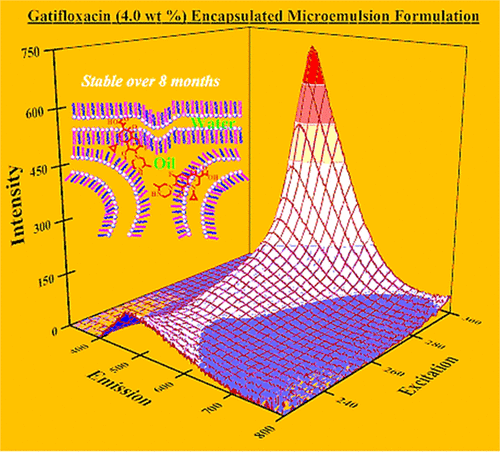Our official English website, www.x-mol.net, welcomes your
feedback! (Note: you will need to create a separate account there.)
Fourth-Generation Antibiotic Gatifloxacin Encapsulated by Microemulsions: Structural and Probing Dynamics
Langmuir ( IF 3.7 ) Pub Date : 2018-08-15 00:00:00 , DOI: 10.1021/acs.langmuir.8b01775 Muhammad Faizan Nazar , Muhammad Yasir Siddique , Muhammad Atif Saleem , Muddassar Zafar , Faisal Nawaz 1 , Muhammad Ashfaq , Asad Muhammad Khan 2 , Hafiz Muhammad Abd Ur Rahman 3 , Muhammad Bilal Tahir , Azwan Mat Lazim 4
Langmuir ( IF 3.7 ) Pub Date : 2018-08-15 00:00:00 , DOI: 10.1021/acs.langmuir.8b01775 Muhammad Faizan Nazar , Muhammad Yasir Siddique , Muhammad Atif Saleem , Muddassar Zafar , Faisal Nawaz 1 , Muhammad Ashfaq , Asad Muhammad Khan 2 , Hafiz Muhammad Abd Ur Rahman 3 , Muhammad Bilal Tahir , Azwan Mat Lazim 4
Affiliation

|
To overcome the increased disease rate, utilization of the versatile broad spectrum antibiotic drugs in controlled drug-delivery systems has been a challenging and complex consignment. However, with the development of microemulsion (μE)-based formulations, drugs can be effectively encapsulated and transferred to the target source. Herein, two biocompatible oil-in-water (o/w) μE formulations comprising clove oil/Tween 20/ethylene glycol/water (formulation A) and clove oil/Tween 20/1-butanol/water (formulation B) were developed for encapsulating the gatifloxacin (GTF), a fourth-generation antibiotic. The pseudoternary phase diagrams were mapped at a constant surfactant/co-surfactant (1:1) ratio to bound the existence of a monophasic isotropic region for as-formulated μEs. Multiple complementary characterization techniques, namely, conductivity (σ), viscosity (η), and optical microscopy analyses, were used to study the gradual changes that occurred in the microstructure of the as-formulated μEs, indicating the presence of a percolation transformation to a bicontinuous permeate flow. GTF showed good solubility, 3.2 wt % at pH 6.2 and 4.0 wt % at pH 6.8, in optimum μE of formulation A and formulation B, respectively. Each loaded μE formulation showed long-term stability over 8 months of storage. Moreover, no observable aggregation of GTF was found, as revealed by scanning transmission electron microscopy and peak-to-peak correlation of IR analysis, indicating the stability of GTF inside the formulation. The average particle size of each μE, measured by dynamic light scattering, increased upon loading GTF, intending the accretion of drug in the interfacial layers of microdomains. Likewise, fluorescence probing sense an interfacial hydrophobic environment to GTF molecules in any of the examined formulations, which may be of significant interest for understanding the kinetics of drug release.
中文翻译:

微乳包封的第四代抗生素加替沙星:结构和探测动力学。
为了克服疾病的增加,在控制药物输送系统中使用多种广谱抗生素药物已成为一项具有挑战性和复杂的任务。但是,随着基于微乳液(μE)的配方的开发,药物可以有效地被封装并转移到目标源。本文开发了两种生物相容性水包油(o / w)μE制剂,分别用于丁香油/吐温20 /乙二醇/水(配方A)和丁香油/吐温20 / 1-丁醇/水(配方B)。封装了第四代抗生素加替沙星(GTF)。伪三元相图以恒定的表面活性剂/助表面活性剂(1:1)比例进行映射,以限制配制成的μEs的单相各向同性区域的存在。多种互补的表征技术,即电导率(σ),粘度(η)和光学显微镜分析被用于研究配制的μEs的微观结构中发生的逐渐变化,表明存在渗流转变为双连续渗流的现象。GTF在制剂A和制剂B的最佳μE中分别显示出良好的溶解度,在pH 6.2下为3.2重量%,在pH 6.8下为4.0重量%。每种上样的μE制剂在储存8个月后均显示出长期稳定性。此外,没有发现可观察到的GTF聚集,如通过扫描透射电子显微镜和IR分析的峰-峰相关所揭示的,表明了制剂内部GTF的稳定性。通过动态光散射测量的每个μE的平均粒径,在加载GTF后会增加,从而使药物在微区的界面层中积聚。同样地,
更新日期:2018-08-15
中文翻译:

微乳包封的第四代抗生素加替沙星:结构和探测动力学。
为了克服疾病的增加,在控制药物输送系统中使用多种广谱抗生素药物已成为一项具有挑战性和复杂的任务。但是,随着基于微乳液(μE)的配方的开发,药物可以有效地被封装并转移到目标源。本文开发了两种生物相容性水包油(o / w)μE制剂,分别用于丁香油/吐温20 /乙二醇/水(配方A)和丁香油/吐温20 / 1-丁醇/水(配方B)。封装了第四代抗生素加替沙星(GTF)。伪三元相图以恒定的表面活性剂/助表面活性剂(1:1)比例进行映射,以限制配制成的μEs的单相各向同性区域的存在。多种互补的表征技术,即电导率(σ),粘度(η)和光学显微镜分析被用于研究配制的μEs的微观结构中发生的逐渐变化,表明存在渗流转变为双连续渗流的现象。GTF在制剂A和制剂B的最佳μE中分别显示出良好的溶解度,在pH 6.2下为3.2重量%,在pH 6.8下为4.0重量%。每种上样的μE制剂在储存8个月后均显示出长期稳定性。此外,没有发现可观察到的GTF聚集,如通过扫描透射电子显微镜和IR分析的峰-峰相关所揭示的,表明了制剂内部GTF的稳定性。通过动态光散射测量的每个μE的平均粒径,在加载GTF后会增加,从而使药物在微区的界面层中积聚。同样地,





















































 京公网安备 11010802027423号
京公网安备 11010802027423号